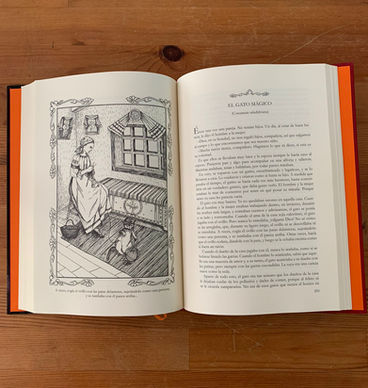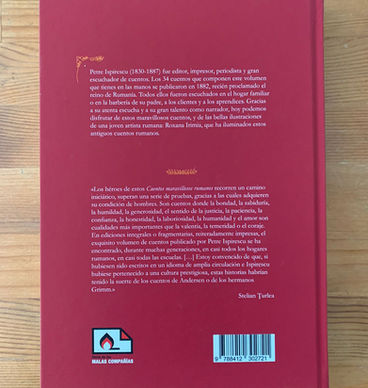Wonderful Romanian Tales

This anthology gathers 34 folk tales that were collected in the 19th century by Petre Ispirescu and translated this year by Mihai Iacob.
The heroes of these Wonderful Romanian Tales follow an initiating journey where they overcome a series of tests that give them their status as men. They are stories where kindness, wisdom, humility, generosity, a sense of justice, patience, trust, honesty, industriousness, humanity and love are more important qualities than bravery, recklessness or courage. (Stelian Turlea)
In this selection of wonderful stories, you can find illustrations by Roxana Irimia, where the human condition of its protagonists stands out.
"Folk tales, when they haven´t been too manhadled by producers or editors in search for the All Publics label, come to work on really lofty concepts." - Culturplaza
This work has received assitance in the form
of a grant from the Spanish Ministry of
Culture and Sports.

Compilation of Petre Ispirescu
Prologue by Stelian Turlea
Translation of Mihai Iacob
Illustrations by Roxana Irimia
Collection: Ancient tales
Size: 18x25cm
Pages: 360
Binding: Cardboard
ISBN: 978.84.123027.2.1
(Price without VAT €27.41)
RRP €28.50
PRESS
Romanian national television echoes the publication of Petre Ispirescu's stories translated into Spanish by Mihai Iacob and illustrated by Roxana Irimia for Libros de las Malas Compañías.
AMOS News
Review of October 15, 2022 in a Romanian online newspaper.
LIRA TV
The book presentation in the Romanian Embassy in
Madrid through its rebroadcasting in LIRA TV.
Estandarte
Here you can find our book's review in the Estandarte magazine.
Culturplaza
Once upon a time the Wonderful Romanian Tales by Petre Ispirescu.
Insightful and thought-inspiring review.
Radio Romania International
An interview to Roxana Irimia, illustrator of the book
Wonderful Romanian Tales.
Roxana Irimia
Born in Pascani (Romania, 1985), she has been living in Spain for 18 years and, since then, she has integrated into the art world in an amazing way.
Roxana has had since her early childhood an inclination for the plastic arts. For her, art is a way of life and of expressing beauty and creativity.
Her work talks about her human condition, an aspect that has always aroused her interest.
Her work has travelled throughout Spain and the world, to cities such as Paris, Rome, Sighisoara, Stockholm, New York, and Los Angeles.
Petre Ispirescu
(Bucharest 1830 - 1887)He is a Romanian publisher, folklorist, printer and publicist. He is best known for his work as a collector of Romanian folktales, relating them with remarkable talent. He grew up listening to countless folktales told by his parents and by customers and apprentices at the family barbershop. His parents wanted him to be a priest and entrusted him to study with a monk at the Metropolitan Church. He abandoned his studies in 1844, at the age of fourteen, and entered an apprenticeship in a printing press, where he became a qualified printer in just 4 years. Since that work, he has gone through various typographies, including the one he founded, the United Workers Typography, he created the Publisher of the Romanian Academy in 1878 and directed the State Printing Office in 1866.
Ispirescu began publishing Romanian folk tales in 1862, at the initiative of Nicolae Filimon. His first collection of six folktales appeared in Țăranul Român and later in booklet form. These tales were later added to his renowned collection, Romanian Fairy Tales, today a bibliographical rarity. He resumed his editorial work in 1872 with the Romanian Popular Tales collection. Riddles and Proverbs, followed by Anecdotes and Popular Tales in 1874, and The Life and Exploits of Mihai Viteazu in 1876.
He was praised for his deep and invaluable knowledge of Romanian folk works.




















